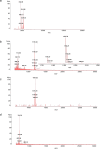Rapid detection of Bacillus ionophore cereulide in food products
- PMID: 30967595
- PMCID: PMC6456620
- DOI: 10.1038/s41598-019-42167-0
Rapid detection of Bacillus ionophore cereulide in food products
Abstract
Cereulide is a toxic cyclic depsipeptide produced by certain strains of Bacillus cereus found in soil and food products. While some harmless strains of Bacillus are used as probiotic, others can cause nausea and vomiting, and represent an important food safety concern. Current detection methods are time consuming and do not necessarily detect toxic cereulide. Here, we developed a rapid protocol using Matrix Assisted Laser Desorption/Ionization-Time of Flight (MALDI-TOF) mass spectrometry that detects the toxin originating from a colony smear of B. cereus. The distinct molecular feature of the toxin peak at m/z 1,191 was clearly identified from bacterial extracts with a limit of detection (LOD) of 30 ng/mL. Final optimisation of the sample preparation was based on cereulide chelating cations to produce the alkali adduct [M + K]+ without the use of a MALDI matrix, and provided a 1,000-fold improvement of LOD with 30 pg/mL of cereulide. We evaluated the application of this method for the detection of cereulide in rice, milk, and different ready-to-eat meals. The proposed protocol is quick, easy and provides an improvement over conventional methods for the detection of B. cereus toxin.
Conflict of interest statement
The authors declare no competing interests.
Figures


Similar articles
-
Simultaneous Discrimination of Cereulide-Producing Bacillus cereus and Psychrotolerant B. cereus Group by Matrix-Assisted Laser Desorption Ionization-Time-of-Flight Mass Spectrometry.J Food Prot. 2022 Aug 1;85(8):1192-1202. doi: 10.4315/JFP-21-450. J Food Prot. 2022. PMID: 35687734
-
A new method for rapid and quantitative detection of the Bacillus cereus emetic toxin cereulide in food products by liquid chromatography-tandem mass spectrometry analysis.Food Microbiol. 2013 May;34(1):29-37. doi: 10.1016/j.fm.2012.11.010. Epub 2012 Nov 28. Food Microbiol. 2013. PMID: 23498175
-
Multiparametric Quantitation of the Bacillus cereus Toxins Cereulide and Isocereulides A-G in Foods.J Agric Food Chem. 2015 Sep 23;63(37):8307-13. doi: 10.1021/acs.jafc.5b03705. Epub 2015 Sep 15. J Agric Food Chem. 2015. PMID: 26352912
-
Why be serious about emetic Bacillus cereus: Cereulide production and industrial challenges.Food Microbiol. 2020 Feb;85:103279. doi: 10.1016/j.fm.2019.103279. Epub 2019 Jul 26. Food Microbiol. 2020. PMID: 31500702 Review.
-
[The significance of some potentially pathogenic microorganisms in occurence of food toxicoinfections. Report 2. Assessment of the role of toxigenic strains of Bacillus cereus].Vopr Pitan. 2012;81(3):24-9. Vopr Pitan. 2012. PMID: 22888667 Review. Russian.
Cited by
-
Metabolite Profiling of Malaysian Gracilaria edulis Reveals Eplerenone as Novel Antibacterial Compound for Drug Repurposing Against MDR Bacteria.Front Microbiol. 2021 Jun 30;12:653562. doi: 10.3389/fmicb.2021.653562. eCollection 2021. Front Microbiol. 2021. PMID: 34276590 Free PMC article.
-
Evaluation of MALDI-ToF Mass Spectrometry for Rapid Detection of Cereulide From Bacillus cereus Cultures.Front Microbiol. 2020 Oct 6;11:511674. doi: 10.3389/fmicb.2020.511674. eCollection 2020. Front Microbiol. 2020. PMID: 33329410 Free PMC article.
-
Plant Growth-Promoting Bacteria as an Emerging Tool to Manage Bacterial Rice Pathogens.Microorganisms. 2021 Mar 26;9(4):682. doi: 10.3390/microorganisms9040682. Microorganisms. 2021. PMID: 33810209 Free PMC article. Review.
-
Advanced Methods for Detection of Bacillus cereus and Its Pathogenic Factors.Sensors (Basel). 2020 May 7;20(9):2667. doi: 10.3390/s20092667. Sensors (Basel). 2020. PMID: 32392794 Free PMC article. Review.
-
Characterization of Bacillus cereus in Dairy Products in China.Toxins (Basel). 2020 Jul 14;12(7):454. doi: 10.3390/toxins12070454. Toxins (Basel). 2020. PMID: 32674390 Free PMC article. Review.
References
Publication types
MeSH terms
Substances
LinkOut - more resources
Full Text Sources
Medical

